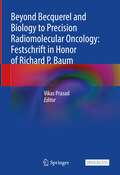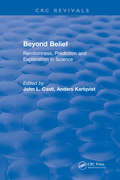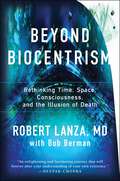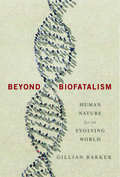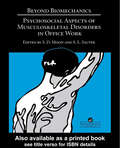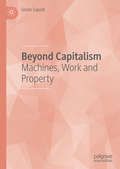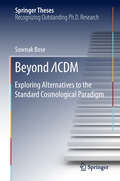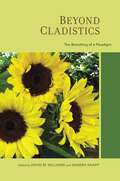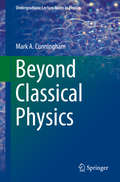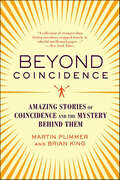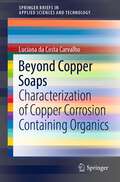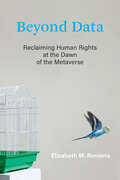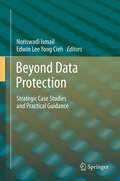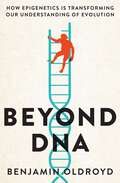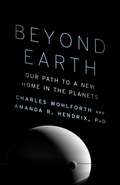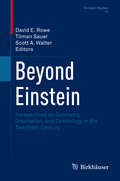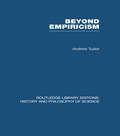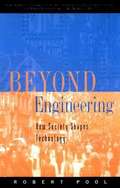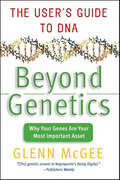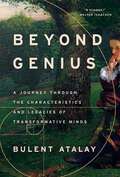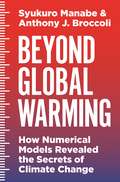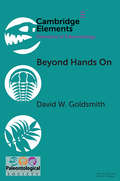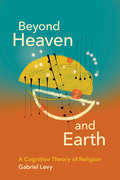- Table View
- List View
Beyond Becquerel and Biology to Precision Radiomolecular Oncology: Festschrift in Honor of Richard P. Baum
by Vikas PrasadThis open access book is written by world-renowned experts on radiomolecular precision oncology to celebrate the work, life, principles and ideology of Richard P Baum.It includes commentaries, reviews and some thought provoking novel ideas on radionuclide precision oncology, covering topics such as various aspects of theranostics and molecular radiotherapy like radiolabeled peptides, radiolabeled antibodies, dosimetry, and quality control as well as the diagnosis and treatment of specific tumor types. Featuring contributions by biologists, physicists, chemists, mathematicians, geneticists, and physicians from a range of specialties, this Festschrift is highly interdisciplinary and will be a valuable resource for future precision oncologists.
Beyond Belief: Randomness, Prediction and Explanation in Science
by John L. CastiHow can we predict and explain the phenomena of nature? What are the limits to this knowledge process? The central issues of prediction, explanation, and mathematical modeling, which underlie all scientific activity, were the focus of a conference organized by the Swedish Council for the Planning and Coordination of Research, held at the Abisko Research Station in May of 1989. At this forum, a select group of internationally known scientists in physics, chemistry, biology, economics, sociology and mathematics discussed and debated the ways in which prediction and explanation interact with mathematical modeling in their respective areas of expertise. Beyond Belief is the result of this forum, consisting of 11 chapters written specifically for this volume. The multiple themes of randomness, uncertainty, prediction and explanation are presented using (as vehicles) several topical areas from modern science, such as morphogenetic fields, Boscovich covariance, and atmospheric variability. This multidisciplinary examination of the foundational issues of modern scientific thought and methodology will offer stimulating reading for a very broad scientific audience.
Beyond Belief: Opportunities for Faith-Engaged Approaches to Climate-Change Adaptation in the Pacific Islands (Climate Change Management)
by Johannes M. Luetz Patrick D. NunnThis interdisciplinary book explores the science and spirituality nexus in the Pacific Islands Region and as such makes a critical contribution to sustainable climate change adaptation in Oceania. In addition to presenting case studies, literary analyses, field projects, and empirical research, the book describes faith-engaged approaches through the prism of: • Context: past, present, and future prospects• Theory: concepts, narratives, and theoretical frameworks• Practice: empirical research and praxis-informed case examples• Doctrine: scriptural contributions and perspectives• Engagement: enlisting religious stakeholders and constituencies Comprising peer-reviewed works by scholars, professionals, and practitioners from across Oceania, the book closes a critical gap in the literature and represents a groundbreaking contribution to holistic climate change adaptation in the Pacific Islands Region that is scientifically sound, spiritually attuned, locally meaningful, and contextually compelling.
Beyond Biocentrism: Rethinking Time, Space, Consciousness, and the Illusion of Death
by Robert Lanza Bob BermanBiocentrism shocked the world with a radical rethinking of the nature of reality. But that was just the beginning. In Beyond Biocentrism, acclaimed biologist Robert Lanza, one of TIME Magazine's "100 Most Influential People in 2014," and leading astronomer Bob Berman, take the reader on an intellectual thrill-ride as they re-examine everything we thought we knew about life, death, the universe, and the nature of reality itself. The first step is acknowledging that our existing model of reality is looking increasingly creaky in the face of recent scientific discoveries. Science tells us with some precision that the universe is 26.8 percent dark matter, 68.3 percent dark energy, and only 4.9 percent ordinary matter, but must confess that it doesn't really know what dark matter is and knows even less about dark energy. Science is increasingly pointing toward an infinite universe but has no ability to explain what that really means. Concepts such as time, space, and even causality are increasingly being demonstrated as meaningless. All of science is based on information passing through our consciousness but science hasn't the foggiest idea what consciousness is, and it can't explain the linkage between subatomic states and observation by conscious observers. Science describes life as a random occurrence in a dead universe but has no real understanding of how life began or why the universe appears to be exquisitely designed for the emergence of life. The biocentrism theory isn't a rejection of science. Quite the opposite. Biocentrism challenges us to fully accept the implications of the latest scientific findings in fields ranging from plant biology and cosmology to quantum entanglement and consciousness. By listening to what the science is telling us, it becomes increasingly clear that life and consciousness are fundamental to any true understanding of the universe. This forces a fundamental rethinking of everything we thought we knew about life, death, and our place in the universe.
Beyond Biofatalism: Human Nature for an Evolving World
by Gillian BarkerBeyond Biofatalism is a lively and penetrating response to the idea that evolutionary psychology reveals human beings to be incapable of building a more inclusive, cooperative, and egalitarian society. Considering the pressures of climate change, unsustainable population growth, increasing income inequality, and religious extremism, this attitude promises to stifle the creative action we require before we even try to meet these threats. Beyond Biofatalism provides the perspective we need to understand that better societies are not only possible but actively enabled by human nature. Gillian Barker appreciates the methods and findings of evolutionary psychologists, but she considers their work against a broader background to show human nature is surprisingly open to social change. Like other organisms, we possess an active plasticity that allows us to respond dramatically to certain kinds of environmental variation, and we engage in niche construction, modifying our environment to affect others and ourselves. Barker uses related research in social psychology, developmental biology, ecology, and economics to reinforce this view of evolved human nature, and philosophical exploration to reveal its broader implications. The result is an encouraging foundation on which to build better approaches to social, political, and other institutional changes that could enhance our well-being and chances for survival.
Beyond Biomechanics: Psychosocial Aspects Of Musculoskeletal Disorders In Office Work
by S. D. Moon S. L. SauterThere is now widespread recognition that psychosocial factors play a key role in the aetiology, perpetuation, management and prevention of cumulative trauma disorders CTDs. This text addresses the strength, direction and importance of links between psychosocial factors and CTDs.; The book's contributors examine critically current research data, ide
Beyond Capitalism: Machines, Work and Property
by Giulio SapelliThis book offers a new perspective on the financialisation of the economy and its profound technological transformation in an increasingly interdependent and globalised world. A deterioration of capitalist property has led to the reactivation of pre-capitalist social phenomena such as slavery. Meanwhile secular deflation and international destruction of the social state have wrought havoc with all familiar modern welfare infrastructure. Yet, Sapelli argues, there is still hope in the form of the gradual evolution of a community-based socialism based on diverse forms of ownership, co-operative living and working, and sustainable capitalist property. Sapelli presents a severe and dramatic look at the present world, where there is still a light at the end of the tunnel.
Beyond ΛCDM: Exploring Alternatives To The Standard Cosmological Paradigm (Springer Theses)
by Sownak BoseThis book employs computer simulations of ‘artificial’ Universes to investigate the properties of two popular alternatives to the standard candidates for dark matter (DM) and dark energy (DE). It confronts the predictions of theoretical models with observations using a sophisticated semi-analytic model of galaxy formation. Understanding the nature of dark matter (DM) and dark energy (DE) are two of the most central problems in modern cosmology. While their important role in the evolution of the Universe has been well established—namely, that DM serves as the building blocks of galaxies, and that DE accelerates the expansion of the Universe—their true nature remains elusive. In the first half, the authors consider ‘sterile neutrino’ DM, motivated by recent claims that these particles may have finally been detected. Using sophisticated models of galaxy formation, the authors find that future observations of the high redshift Universe and faint dwarf galaxies in the Local Group can place strong constraints on the sterile neutrino scenario. In the second half, the authors propose and test novel numerical algorithms for simulating Universes with a ‘modified’ theory of gravity, as an alternative explanation to accelerated expansion. The authors’ techniques improve the efficiency of these simulations by more than a factor of 20 compared to previous methods, inviting the readers into a new era for precision cosmological tests of gravity.
Beyond Cladistics: The Branching Of A Paradigm (Species And Systematics Ser. #3)
by Sandra Knapp David M. WilliamsCladistics, or phylogenetic systematics--an approach to discovering, unraveling, and testing hypotheses of evolutionary history--took hold during a turbulent and acrimonious time in the history of systematics. During this period--the 1960s and 1970s--much of the foundation of modern systematic methodology was established as cladistic approaches became widely accepted. Virtually complete by the end of the 1980s, the wide perception has been that little has changed. This volume vividly illustrates that cladistic methodologies have continued to be developed, improved upon, and effectively used in ever widening analytically imaginative ways.
Beyond Classical Physics (Undergraduate Lecture Notes in Physics)
by Mark A. CunninghamThis undergraduate textbook discusses the nature of the microscopic universe from a modern perspective, based on Einstein's notions of relativity and Noether's proof of the emergence of conservation laws from symmetries of the equations of motion. These ideas drove the development of the Standard Model of particle physics and subsequent attempts to define a unified (string) theory. The second half of the book explores various aspects of many-body physics, ranging from chemical systems to plasmas to black holes. Like the previous textbook authored by by Mark Cunningham, Neoclassical Physics, this text uses a guided discovery approach of instruction, highlighting the experimental results that drove development of our modern picture of subatomic physics. Many problems utilize Mathematica#65533; software to enable students to explore the meaning of different equations in a graphical manner. Students will gain an appreciation of the current state of physical theory, in preparation for more detailed, advanced study as upperclassmen.
Beyond Coincidence: Amazing Stories of Coincidence and the Mystery Behind Them
by Martin Plimmer Dr. Brian KingEver wonder what the odds are of being struck by lightning? Or winning the lottery? Or meeting someone from Timbuktu with the same middle name as you?BEYOND COINCIDENCE recounts and analyzes over 200 amazing stories of synchronicity, the likes of:Laura Buxton, age ten, releases a balloon from her back yard. It lands 140 miles away in the backyard of another Laura Buxton, also age ten.Two sisters in Alabama decide, independently, to visit the other. En route, their identical jeeps collide and both sisters are killed.A British cavalry officer was fighting in the last year of World War One when he was knocked off his horse by a flash of lightning. He was paralyzed from the waist down. The man moved to Vancouver, Canada where, six years later, while fishing in a river, lightning struck him again, paralyzing his right side. Two years later, he was sufficiently recovered to take walks in a local park when, in 1930, lightning sought him out again, this time permanently paralyzing him. He died soon after. Four years later, lightning destroyed his tomb.
Beyond Copper Soaps: Characterization of Copper Corrosion Containing Organics (SpringerBriefs in Applied Sciences and Technology)
by Luciana da CarvalhoThis book reports a series of electrochemical experiments where copper was corroded in the presence of various organic substances. Combining data from spectroscopy techniques, X-ray diffraction and mass spectrometry (including proteomics) the experiments demonstrate that copper-organic complexes can be formed during the corrosion of copper. The low solubility of copper-organic complexes in organic solvents and their amorphous nature mean that these compounds cannot be easily detected by one single analytical technique. This book benefits researchers investigating the presence of organic residues in archaeological copper corrosion and copper-organic complexes in art, where sampling is often subject to curatorial constraints.
Beyond Data: Reclaiming Human Rights at the Dawn of the Metaverse
by Elizabeth M. RenierisWhy laws focused on data cannot effectively protect people—and how an approach centered on human rights offers the best hope for preserving human dignity and autonomy in a cyberphysical world.Ever-pervasive technology poses a clear and present danger to human dignity and autonomy, as many have pointed out. And yet, for the past fifty years, we have been so busy protecting data that we have failed to protect people. In Beyond Data, Elizabeth Renieris argues that laws focused on data protection, data privacy, data security and data ownership have unintentionally failed to protect core human values, including privacy. And, as our collective obsession with data has grown, we have, to our peril, lost sight of what&’s truly at stake in relation to technological development—our dignity and autonomy as people. Far from being inevitable, our fixation on data has been codified through decades of flawed policy. Renieris provides a comprehensive history of how both laws and corporate policies enacted in the name of data privacy have been fundamentally incapable of protecting humans. Her research identifies the inherent deficiency of making data a rallying point in itself—data is not an objective truth, and what&’s more, its &“entirely contextual and dynamic&” status makes it an unstable foundation for organizing. In proposing a human rights–based framework that would center human dignity and autonomy rather than technological abstractions, Renieris delivers a clear-eyed and radically imaginative vision of the future. At once a thorough application of legal theory to technology and a rousing call to action, Beyond Data boldly reaffirms the value of human dignity and autonomy amid widespread disregard by private enterprise at the dawn of the metaverse.
Beyond Data Protection: Strategic Case Studies and Practical Guidance
by Edwin Lee Yong Cieh Noriswadi IsmailThe book deals with data protection issues from practical viewpoints. 40% of the content focus on the Malaysian Personal Data Protection Act (PDPA) 2010 progress, whilst 60% of the content focus on leading comparative practical guidance from Europe. Part of the PDPA provisions is mirrored from European approaches and practices. The approach of this book is straightforward, handy and readable and is supplemented by practical applications, illustrations, tables and diagrams. Practical examples highlighted in this book range from cloud computing, radio frequency identification technology, social media networks and information security to basic related aspects of data protection issues covering strategic leadership, management, governance and audit in businesses, organisations and local authorities. Recommended best practices have been outlined for practical guidance accompanied with future challenges and opportunities for Malaysia and ASEAN. The book is equally suitable for academics, practitioners, governmental officials and regulators dealing with data protection within their sector-specific legislation.
Beyond DNA: How Epigenetics is Transforming our Understanding of Evolution
by Benjamin OldroydBeyond DNA is a journey through uncharted territory, advancing new ways of thinking about evolution and adaptation. For nearly a hundred years evolutionary biologists have understood that evolution proceeds by substituting better genes for less good ones. But consensus is growing that this is not the whole story: geneticists are now revealing that spores, sperm, pollen and ova are packed with personalised genetic information that plays an important role in offspring development and has lifelong effects. This epigenetic - or 'extra-genetic ' -inheritance therefore makes significant contributions to evolutionary processes. In this highly accessible book, packed with instructive examples, Benjamin Oldroyd explains how a greater appreciation of the role of epigenetics is helping to solve a multitude of previously intractable problems in evolutionary biology - puzzles as varied as why invasive plants and animals can rapidly adapt to changes in their environment, how worker bees and queen bees can develop from the same egg, and why cancer becomes more common as we age. Beyond DNA concisely explains the mechanisms that underlie epigenetics, shows how epigenetic processes can lead to adaptation, and speculates on meaty issues such as the role that epigenetics plays in human health and happiness.
Beyond Earth: Our Path to a New Home in the Planets
by Amanda Hendrix Charles WohlforthFrom a leading planetary scientist and an award-winning science writer, a propulsive account of the developments and initiatives that have transformed the dream of space colonization into something that may well be achievable. We are at the cusp of a golden age in space science, as increasingly more entrepreneurs--Elon Musk, Richard Branson, Jeff Bezos--are seduced by the commercial potential of human access to space. But Beyond Earth does not offer another wide-eyed technology fantasy: instead, it is grounded not only in the human capacity for invention and the appeal of adventure but also in the bureaucratic, political, and scientific realities that present obstacles to space travel--realities that have hampered NASA's efforts ever since the Challenger disaster. In Beyond Earth, Charles Wohlforth and Amanda R.Hendrix offer groundbreaking research and argue persuasively that not Mars, but Titan--a moon of Saturn with a nitrogen atmosphere, a weather cycle, and an inexhaustible supply of cheap energy, where we will even be able to fly like birds in the minimal gravitational field--offers the most realistic and thrilling prospect of life without support from Earth.(With 8 pages of color illustrations) From the Hardcover edition.
Beyond Einstein: Perspectives on Geometry, Gravitation, and Cosmology in the Twentieth Century (Einstein Studies #14)
by David E. Rowe Tilman Sauer Scott A. WalterBeyond Einstein: Perspectives on Geometry, Gravitation, and Cosmology explores the rich interplay between mathematical and physical ideas by studying the interactions of major actors and the roles of important research communities over the course of the last century.
Beyond Einstein Gravity: The Minimal Geometric Deformation Approach in the Brane-World (SpringerBriefs in Physics)
by Jorge Ovalle Roberto CasadioThis book serves two main purposes: firstly, it shows, in a simple way, how the possible existence of an extra-spatial dimension would affect the predictions of four-dimensional General Relativity, a model known as the Brane world; secondly, it explains, step-by-step, a new technique called Minimal Geometric Deformation, which was introduced for the purpose of solving the correspondingly modified Einstein field equations. This method gave rise to the Gravitational Decoupling in General Relativity, which is widely used to solve the Einstein field equations in various contexts.
Beyond Empiricism: Philosophy of Science in Sociology (Routledge Library Editions: History & Philosophy of Science)
by Andrew TudorOriginally published in 1982. This volume explores some features of modern philosophy of science from the point of view of their utility for sociology’s self-understanding. Recently philosophers of science have broken with the empiricism once fundamental to their discipline, and have sought alternative methods of science. Founded on the belief that these developments are significant for sociologists, the book explores the failings of the old "received view" and some of the more recent alternatives. It proposes a schematic outline of the structure of inquiry, paying detailed attention to questions about the nature of theory, explanation and demonstration.
Beyond Engineering: How Society Shapes Technology (Sloan Technology Series)
by Robert PoolWe have long recognized technology as a driving force behind much historical and cultural change. Now, in Beyond Engineering, science writer Robert Pool turns the question around to examine how society shapes technology. Drawing on such disparate fields as history, economics, risk analysis, management science, sociology, and psychology, Pool illuminates the complex, often fascinating interplay between machines and society, in a book that will revolutionize how we think about technology. We tend to think that reason guides technological development, that engineering expertise alone determines the final form an invention takes. But if you look closely enough at the history of any invention, says Pool, you will find that factors unrelated to engineering seem to have an almost equal impact. In his wide-ranging volume, he traces developments in nuclear energy, automobiles, light bulbs, commercial electricity, and personal computers, to reveal that the ultimate shape of a technology often has as much to do with happenstance, business acumen, and cultural context. Whether discussing bovine growth hormone, nuclear power plants, or baboon-to-human transplants, Beyond Engineering is an engaging look at modern technology and an illuminating account of how technology and the modern world shape each other.
Beyond Genetics: The User's Guide to DNA
by Glenn McGeeGenetic science is about to radically alter our lives. Sooner than you can imagine, human beings will be capable of diagnosing their own illnesses, designating the sex of their children, even designing the food they eat -- all as easily as using a cell phone. Now is the time for every one of us to take control of our DNA, and one man is uniquely qualified to show us how: Glenn McGee, bioethicist at the University of Pennsylvania, pioneer in the study of "home genetics," and the acknowledged wunderkind of the exciting world found at the nexus of life science and computer technology.One of the most respected authorities in the field of genomics -- the study of the genetic "software" inside plants, animals, and us -- McGee takes us on an eye-opening journey behind the headlines and into the heart of this formidable cutting-edge science. Probing the far-ranging ethical and legal implications of genomic research, McGee tackles its most controversial and hotly debated aspects -- from patenting your DNA to genetic engineering at the supermarket -- and explodes unnecessary fears about this wondrous new knowledge.We live in a brave new world. Beyond Genetics provides us with the knowledge we need to take the right steps forward into tomorrow ... and beyond.
Beyond Genius: A Journey Through the Characteristics and Legacies of Transformative Minds
by Bulent AtalayAn in-depth and unified exploration of genius in the arts and sciences through the life and works of five seminal intellectual and cultural figures: Leonardo da Vinci, William Shakespeare, Isaac Newton, Ludwig von Beethoven, and Albert Einstein.Who among us hasn't read Hamlet, listened to the Fifth Symphony, gazed at the Mona Lisa, or marveled at the three laws of physics and the Theory of Relativity and been struck with the same simple question: how on Earth did they do it? Where did these masters draw inspiration to produce some of the most stunning achievements in human history? Were their brains wired differently than ours? Did they have special traits or unique experiences that set them on the path to greatness? Genius is a broad and elusive concept, one that is divisive and hard to define—and gravely misunderstood. There are &“ordinary&” geniuses who achieve remarkable feats of brilliance, as well as &“magicians&” (a term James Gleick invoked to describe Richard Feynman) who make an outsize impact on their given field. But highest among them are transformative geniuses, those rare individuals who redefine their fields or open up new universes of thought altogether. These are the masters whose genius Bulent Atalay decodes in his engrossing, enlightening, and revelatory book. No, Atalay doesn&’t have a road map for how we might become the next Einstein or Leonardo, but his revolutionary study of genius gives us a stunning new lens through which to view humanity&’s most prolific thinkers and creators and perhaps pick up some inspiration along the way. At first, it seems that transformative geniuses don&’t follow any sort of topography. Their prodigious output looks effortless, they leap from summit to summit, and they probably couldn&’t explain exactly how they went about solving their problems. They might not even recognize themselves in the ways we talk about them today. Atalay argues that these heroes fit more of a mold than we might think. As evidence, he rigorously dissects the lives, traits, habits, and thought patterns of five exemplars—Leonardo, Shakespeare, Newton, Beethoven, and Einstein— to map the path of the transformative genius. How did Beethoven, who could not perform basic multiplication, innately encode the Fibonacci Sequence in his symphonies? Is it possible that we understate Shakespeare&’s poetic influence? How did Leonardo become equally prolific in both the arts and the sciences? How did Newton formulate the universal laws of physics, the basis of so many other sciences? And what prompted TIME Magazine to declare Einstein, a man whose very name is synonymous with genius, the &“Individual of the 20th Century&”? With great clarity and attention to detail, Atalay expertly traces how these five exemplars ascended to immortality and what their lives and legacies reveal about how transformative geniuses are made
Beyond Global Warming: How Numerical Models Revealed the Secrets of Climate Change
by Syukuro Manabe Anthony J. BroccoliA definitive account of how we have come to understand the fundamental processes behind global warmingSyukuro Manabe is perhaps the leading pioneer of modern climate modeling. Beyond Global Warming is his compelling firsthand account of how the scientific community came to understand the human causes of climate change, and how numerical models using the world’s most powerful computers have been instrumental to these vital discoveries.Joined by atmospheric scientist Anthony Broccoli, Manabe shows how climate models have been used as virtual laboratories for examining the complex planetary interactions of atmosphere, ocean, and land. Manabe and Broccoli use these studies as the basis for a broader discussion of human-induced global warming—and what the future may hold for a warming planet. They tell the stories of early trailblazers such as Svante Arrhenius, the legendary Swedish scientist who created the first climate model of Earth more than a century ago, and they provide rare insights into Manabe’s own groundbreaking work over the past five decades. Expertly walking readers through key breakthroughs, they explain why increasing atmospheric carbon dioxide has caused temperatures to rise in the troposphere yet fall in the stratosphere, why the warming of the planet’s surface differs by hemisphere, why drought is becoming more frequent in arid regions despite the global increase in precipitation, and much more.Authoritative and illuminating, Beyond Global Warming is an invaluable insider’s look at some of today’s most cutting-edge Earth science, and a rare window into a brilliant scientific mind.
Beyond Hands On: Incorporating Kinesthetic Learning in an Undergraduate Paleontology Class (Elements of Paleontology)
by David W. GoldsmithHands-on learning in paleontology, and geology in general, is fairly common practice. Students regularly use rocks, fossils, and data in the classroom throughout their undergraduate career, but they typically do it sitting in a chair in a lab. Kinesthetic learning is a teaching model that requires students to be physically active while learning. Students may be involved in a physical activity during class or might be using their own bodies to model some important concept. This book briefly discusses the theory behind kinesthetic learning and how it fits into a student-centered, active-learning classroom. It then describes in detail methods for incorporating it into student exercises on biostratigraphy, assessment of sampling completeness, and modeling evolutionary processes. Assessment data demonstrates that these exercises have led to significantly improved student learning outcomes tied to these concepts.
Beyond Heaven and Earth: A Cognitive Theory of Religion
by Gabriel LevyAn approach to understanding religion that draws on both humanities and natural science but rejects approaches that employ simple monisms and radical dualisms. In Beyond Heaven and Earth, Gabriel Levy argues that collective religious narratives and beliefs are part of nature; they are the basis for the formation of the narratives and beliefs of individuals. Religion grows out of the universe, but to make sense of it we have to recognize the paradox that the universe is both mental and material (or neither). We need both humanities and natural science approaches to study religion and religious meaning, Levy contends, but we must also recognize the limits of these approaches. First, we must make the dominant metaphysics that undergird the various disciplines of science and humanities more explicit, and second, we must reject those versions of metaphysics that maintain simple monisms and radical dualisms. Bringing Donald Davidson&’s philosophy—a form of pragmatism known as anomalous monism—to bear on religion, Levy offers a blueprint for one way that the humanities and natural sciences can have a mutually respectful dialogue. Levy argues that in order to understand religions we have to take their semantic content seriously. We need to rethink such basic concepts as narrative fiction, information, agency, creativity, technology, and intimacy. In the course of his argument, Levy considers the relation between two closely related semantics, fiction and religion, and outlines a new approach to information. He then applies his theory to discrete cases: ancient texts, modern media, and intimacy.
